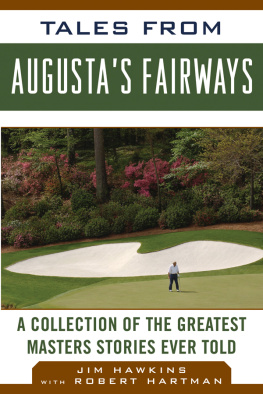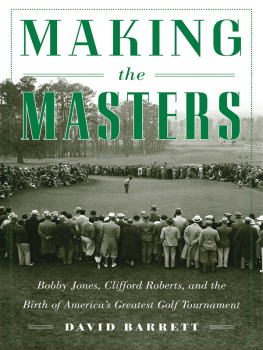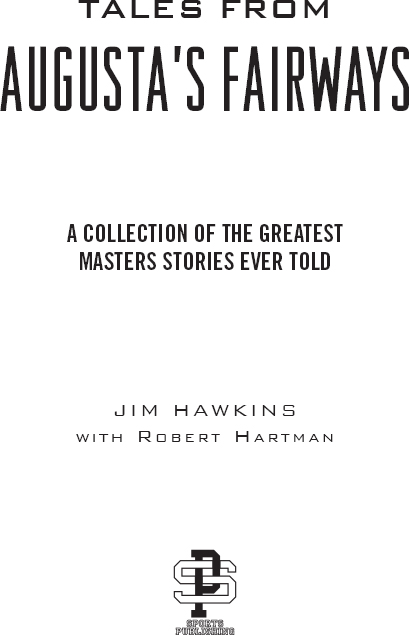1
Cathedral in the Pines
_____________________
The Masters is a monument to everything that is great in golf. It is a cut above. Way above.
Jack Nicklaus
The first thing that strikes you, the first time you set foot on hallowed, immaculate Augusta National, is how utterly green everything is. How absolutely perfect.
Instantly, you can understand how Masters founder and amateur legend Bobby Jones felt, more than 70 years ago, when he first laid eyes on the paradise that would become Augusta National.
In his autobiography, Golf is My Game, Jones wrote:
When I walked out on the grass terrace under the big trees behind the house and looked down over the property, the experience was unforgettable. it seemed that this land had been lying here for years waiting for someone to lay a golf course upon it. indeed, it looked as though it already were a golf course
To this day, the breathtaking scene virtually explodes right before your eyes:
Majestic, carpet-like, rolling green fairways, framed by towering green loblolly pine trees, leading, of course, to impeccably manicured greens.
Then you notice the picturesque ponds, filled with reflections of flawless pink and white flowers, the caddies clad in their distinctive, snow-white coveralls, and the charming pine straw paths. There are 1,600 azaleas on hole No. 13 alone.
At the rear of the stately, steepled white clubhouse with black shuttersthe first all-concrete structure erected in the South (when it was built in 1854 as a home for Dennis Redmond, who owned the thriving indigo plantation on the property at the time)stands a 150-year-old oak tree.
Planted before the start of the Civil War, it is now three stories high, stretching 40 yards from limb to limb.
Before Bobby Jones, before Ben Hogan, before Arnold Palmer, before Jack Nicklaus, before Tiger Woods, that oak tree was there, overlooking what is now the first tee of the most famous, the most venerated golf course in the world.
There is no swimming pool at Augusta National. No tennis courts. Augusta National is not like other country clubs. There isnt even an annual club championship.
Exalted Augusta National is all about the Masters. Period.
You will find no billboards at Augusta National. No blimps flying overhead during the Masters. No skyboxes, no corporate hospitality chalets or tents.
No sponsor is wanted. Nor is one needed here.
Augusta National, where the quaint scoreboards are still operated by hand and where thousands of pimento cheese sandwiches are painstakingly wrapped year after year in green cellophane, doesnt simply exhibit tradition and nostalgia and class.
It exudes it.
Those indigo plants on Dennis Redmonds plantation produced berries that were the source of the dark blue dye that was used in the late 1800s to produce a popular new piece of apparel known as blue jeans.
Today, no one in the know would dare to wear blue jeans at dignified Augusta National
The first Masters was played in late March, but the next year it was moved to April where, thanks to Augusta Nationals blooming azaleas, dogwoods, and rosebuds, the tournament soon became one of the traditional harbingers of springand the new golf season.
Many of the plants that bloom each April at Augusta are direct descendants of the flowers once featured at Fruitlands Nursery, which formerly flourished on the grounds.
When co-founder Clifford Roberts proposed moving the Masters to the first week in April in the late 1930s, an Augusta National club member noted: The problem is, that means well finish on Easter Sunday.
Well, whos in charge of scheduling Easter this year? Roberts inquired. Well get them to move it.
Augusta Nationals dense hedges hide the peaceful patch of heaven from the prying eyes of uninvited passers-by on frenzied, fast-food filled Washington Road. A trip to the Masters truly is a trip back in time to a more genteel era when golf was primarily a game for a privileged, well-to-do few.
Each April, the gentlemen in green jackets open their gates and allow everyone lucky enough to land a ticket a peek into their private little paradise.
Once inside the sanctuary people patiently stand in line for hours for the privilege of purchasing an official Masters shirt or cap to prove to friends back home that they actually were there.
Since the inaugural Masters in 1934, the familiar Augusta National map-and-flagstick logo has never varied.
Very few ardent golf enthusiasts follow the prestigious U.S. Open from venue to venue, year after year. But thousandsarguably, tens of thousandsreturn to Augusta National each April.
The minute you drive in these gates, you begin to choke up, admitted Gary Player, who has conquered glorious Augusta National three times.
In the early years, sportswriters, heading home to the Northeast and Midwest after baseballs annual spring training in Florida, were happy to stop off in hospitable Augusta along the way
That helped to promote the Masters. it also didnt hurt that Grantland Rice, the countrys foremost sports-writer at the time and a nationally known celebrity, was one of Augusta Nationals most active, enthusiastic members.
Because of Jones and Roberts attention to detail, the Masters soon gained a reputation for being the best-run golf tournament in the worlda distinction that sets Augusta National apart to this day
Masters spectators are called patrons, not fans. The sand-filled hazards at the Masters are referred to as bunkers, not traps. The conveniently placed barrels are filled with refuse, never garbage or trash.
The two halves of the storied golf course are referred to as the first nine and the second nine, rather than front and back, because Clifford Roberts who added to the lore of Augusta by committing suicide in 1977 at age 84 on the adjacent par-3 course believed the phrase back side sounded vulgar.
The Masters is, without a doubt, the toughest ticket in sports. Yet prices at Augusta National remain a fraction of what the market would bear.
Parking for patrons is free. Augusta National was the first course to provide complimentary parking on club grounds for 10,000 cars.
The Masters was also the first tournament to provide bleachersor observation stands, as Roberts called themfor the comfort of spectators. And it was the first golf tournament to be broadcast live from coast to coast on radio.










